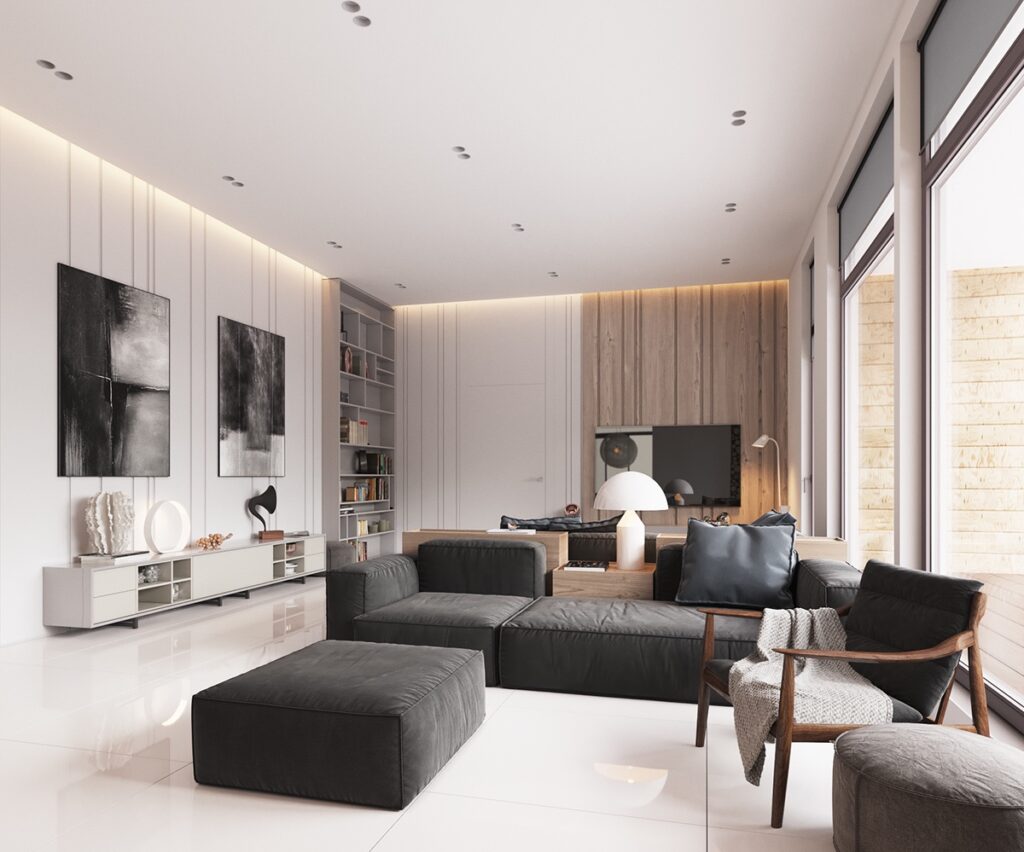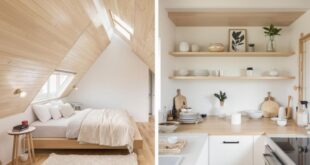
The Allure of the Minimalist Home: Creating Serenity and Space
In an increasingly cluttered world, the concept of a minimalist home has gained significant traction. More than just a design trend, it represents a conscious choice to prioritize experiences over possessions, creating a living space that fosters serenity, reduces stress, and promotes a more intentional lifestyle. This article delves into the core principles of minimalist living, exploring its benefits, practical implementation strategies, and the profound impact it can have on your overall well-being.
Understanding the Core Principles of Minimalist Living
At its heart, minimalism is about intentionality. It’s about consciously choosing what you bring into your life and, equally importantly, what you let go of. This extends beyond just physical possessions to encompass digital clutter, commitments, and even relationships that no longer serve you. A minimalist home is therefore a reflection of this intentionality, a carefully curated space that contains only items that are truly useful, beautiful, or meaningful.
- Less is More: This is the foundational principle. It emphasizes quality over quantity and focuses on owning fewer, higher-quality items.
- Intentionality: Every item in your home should have a purpose or bring you joy. If it doesn’t, consider letting it go.
- Functionality: Prioritize items that serve a practical purpose. A minimalist home is not about sacrificing comfort or functionality, but about choosing items that are both aesthetically pleasing and useful.
- Open Space: Minimalism emphasizes creating open and uncluttered spaces. This can be achieved by decluttering, organizing, and using storage solutions effectively.
- Sustainability: Often, minimalism aligns with sustainable living practices. By consuming less and choosing durable, high-quality items, you can reduce your environmental impact.
The Benefits of Embracing a Minimalist Home
The advantages of adopting a minimalist approach to your home extend far beyond aesthetics. A minimalist home can have a profound impact on your mental, emotional, and even physical well-being.
Reduced Stress and Anxiety
Clutter can be a significant source of stress and anxiety. A cluttered environment can overwhelm the senses, making it difficult to focus and relax. By decluttering and simplifying your living space, you can create a more calming and peaceful environment. A minimalist home promotes a sense of order and control, which can help to reduce stress and anxiety levels.
Increased Productivity and Focus
A clear space can lead to a clear mind. When your surroundings are free from distractions, it becomes easier to focus on the task at hand. A minimalist home can help to improve productivity by minimizing distractions and creating a more conducive environment for work and creativity.
More Time and Energy
Think about all the time you spend cleaning, organizing, and maintaining your possessions. By owning less, you can free up valuable time and energy that can be directed towards more meaningful activities. A minimalist home requires less upkeep, allowing you to focus on your passions, relationships, and personal growth.
Financial Freedom
Minimalism encourages mindful spending and discourages impulsive purchases. By focusing on needs rather than wants, you can save money and achieve greater financial freedom. A minimalist home is not about deprivation, but about making conscious choices about how you spend your money.
Enhanced Creativity and Inspiration
A minimalist environment can foster creativity and inspiration. By removing distractions and creating a sense of calm, you can open yourself up to new ideas and perspectives. A minimalist home can be a sanctuary where you can connect with your inner self and explore your creative potential.
Practical Steps to Creating Your Minimalist Home
Transforming your home into a minimalist haven is a journey, not a destination. It requires patience, commitment, and a willingness to let go of things that no longer serve you. Here are some practical steps to get you started:
Start Small
Don’t try to declutter your entire house in one day. Begin with a small area, such as a drawer, a shelf, or a corner of a room. Once you’ve tackled a small area, you’ll feel more motivated to continue.
The Four-Box Method
Grab four boxes and label them: Keep, Donate, Sell, and Trash. Go through your belongings one by one and place them in the appropriate box. Be honest with yourself about what you truly need and use.
The One-In, One-Out Rule
For every new item you bring into your home, get rid of one similar item. This helps to prevent clutter from accumulating.
Focus on Functionality
When choosing new items for your home, prioritize functionality and durability. Choose items that are well-made and will last for years to come. Avoid buying cheap, disposable items that will only end up in the landfill.
Embrace Vertical Storage
Utilize vertical storage solutions to maximize space. Shelves, cabinets, and wall-mounted organizers can help to keep your belongings organized and out of sight. Consider using clear containers to easily see what’s inside.
Digital Decluttering
Don’t forget to declutter your digital life as well. Delete unnecessary files, unsubscribe from emails, and organize your digital photos. A clean digital space can contribute to a more peaceful and organized mind. [See also: Digital Minimalism: A Guide to Intentional Technology Use]
The Importance of Letting Go
The hardest part of minimalism is often letting go of things that you have an emotional attachment to. However, it’s important to remember that your possessions don’t define you. Letting go of things that you no longer need or use can be liberating and empowering. Consider donating items to charity or selling them online to give them a new life.
Designing Your Minimalist Home Aesthetic
While minimalism is primarily a lifestyle choice, it also influences design aesthetics. A minimalist home often features clean lines, neutral colors, and a focus on natural light. However, minimalism doesn’t have to be sterile or boring. You can incorporate personal touches and elements that reflect your unique style.
Color Palette
Stick to a neutral color palette, such as white, gray, beige, and earth tones. These colors create a sense of calm and serenity. You can add pops of color with accessories, such as pillows, throws, and artwork. [See also: Choosing the Right Color Palette for Your Home]
Furniture
Choose furniture that is simple, functional, and well-made. Opt for pieces with clean lines and minimal ornamentation. Avoid bulky or ornate furniture that can clutter the space.
Lighting
Maximize natural light by keeping windows clear and using light-colored curtains or blinds. Supplement natural light with artificial lighting that is soft and warm. Avoid harsh fluorescent lighting.
Accessories
Choose accessories carefully and intentionally. Avoid cluttering surfaces with knick-knacks and decorative items. Focus on a few key pieces that are meaningful and visually appealing.
Maintaining Your Minimalist Lifestyle
Creating a minimalist home is just the first step. Maintaining a minimalist lifestyle requires ongoing effort and commitment. Here are some tips to help you stay on track:
Regular Decluttering
Make decluttering a regular habit. Set aside a few minutes each week to go through your belongings and get rid of anything you no longer need or use.
Mindful Consumption
Be mindful of your consumption habits. Before making a purchase, ask yourself if you truly need the item and if it aligns with your minimalist values.
Avoid Impulse Purchases
Resist the urge to make impulse purchases. Take some time to think about whether you really need the item before buying it.
Embrace Experiences
Focus on experiences rather than possessions. Spend your time and money on activities that bring you joy and create lasting memories. A minimalist home supports a lifestyle rich in experiences.
Conclusion: Embracing a Life of Intention
The minimalist home is more than just a design trend; it’s a conscious choice to live with intention and purpose. By decluttering your physical space, you can create a more calming, productive, and fulfilling life. Embracing minimalism is a journey, but the rewards are well worth the effort. Start small, be patient, and enjoy the process of creating a minimalist home that reflects your values and supports your well-being. Ultimately, the goal is to create a space that allows you to focus on what truly matters: your relationships, your passions, and your personal growth. The journey to a minimalist home is a journey to a more intentional and fulfilling life. Embrace the change and discover the freedom that comes with owning less and living more. Consider starting your journey toward a minimalist home today.
 Nimila
Nimila




![Minimalist Home: Design, Benefits & Expert Guide [2024] Minimalist Home: Design, Benefits & Expert Guide [2024]](https://nimila.me/wp-content/uploads/2025/06/minimalisthomedecortips-310x165.jpg)